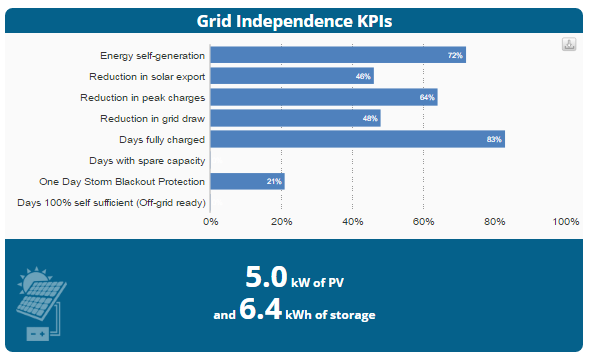The age of grid-connected home battery storage is upon us. While battery price points aren’t yet low enough for us to start seeing mass uptake, they are low enough to be attractive for a disparate group of people lumped into the category of ‘early adopters’. Early adopters of home battery storage systems may come from a range of backgrounds and have a range of motivations, but there are a number of things that they’ll have in common. What characteristics do battery storage early adopters share – and do you fit the bill?
The main things battery storage early adopters have in common
We’ll loosely define battery storage early adopters as people who get batteries installed on a grid-connected solar system despite relatively high prices and less than stellar returns. Below is a list of a few core things that battery storage early adopters are likely to have in common.
 Solar panels (or a plan to get them)
Solar panels (or a plan to get them)
One of the main reasons battery storage is becoming such a big thing in Australia is the fact that so many grid-connected homes have solar panels on their roofs. Solar power is already affordable in Australia, and makes sense for almost every home with some unshaded roof space and a bit of daytime electricity consumption. Most households that get battery storage will do so to soak up their excess solar energy.
Distaste for low solar feed-in rates
These days, most states do not require electricity retailers to pay solar customers anything for the solar that they send into the grid. Most retailers will have some sort of voluntary solar feed-in tariff offering, but these rates tend to be on the low side – usually about 6-8c per kilowatt-hour (kWh). It’s no surprise, therefore, that most solar homes opt to ‘self-consume‘ as much of their solar energy as possible; by doing so, they reduce the amount of energy they need to purchase from their retailer in the first place, thereby reducing their power bills. Batteries enable homes to put their solar to good use even if they’re not around to use it when the sun is shining.
 Desire to reduce their electricity bills
Desire to reduce their electricity bills
A solar-plus-storage system is a great way to cut your electricity bills. In fact, with a big enough system, you could potentially eliminate the ‘consumption charges’ component of your bill altogether. Keep in mind, however, that there will always be daily fixed supply charges that still apply – so beware of of companies promising ‘No more power bills!’ because they’re almost certainly lying to you.
Compare battery storage options in your area: Complete the Solar Quote Comparison request form to the right of this page.
A bit of extra cash kicking around (or access to a decent financing package)
Batteries are more affordable than they’ve ever been, but they definitely haven’t reached the near-commodity status of solar panels in Australia. As such, early adopters will largely be people with a few thousand dollars sitting in the bank to put towards them. Alternatively, it might make sense to have them installed on financing plan – as long as the savings still pan out.
Willingness to accept a slightly longer payback period and lower ROI than solar alone
Relatively high price points for batteries mean that a solar-plus-storage system will almost always have a longer payback period than a solar only system – even as they do a better job of reducing your electricity bill. Fortunately, we’re beginning to see price points at which a battery bank will pay for itself before the warranty period expires (usually 5-10 years). This means that while batteries may not be the most cracking of investments (if you consider all the options available), they’re also not a waste of money.
Rough example payback estimates for a solar-only system vs a solar-plus-storage system. (Check out our Solar and Battery Storage System Sizing & Payback Estimator Tool to explore for yourself.)
Other things characteristics battery early adopters might share
Desire for increased energy independence
One thing that home battery storage is great at helping a household achieve is a higher degree of energy independence. With the right size of solar system and battery bank, it’s completely possible for a household to meet the bulk of their electricity needs without drawing from the grid – although the grid will always be there as a ‘backup’.
Grid independence key performance indicators (KPIs) as displayed in an infographic created using SunWiz’s PVSell software.
Interest in or need for battery backup power
Another great feature that some (but not all – caveat emptor!) battery storage systems provide is the ability to keep the lights on even when the grid is down. Early adopters of battery storage may want (or have a need for) backup functionality.

Lights on at the home of Redflow CEO Simon Hackett during the recent blackout in South Australia.
Keenness for gadgets & new technologies
Battery storage systems are seriously the next big thing in the electricity sector – the incredible buzz created by Tesla Motors with the launch of its Powerwall was testament to this fact. Many early adopters will be people who like having the newest technology. With battery storage, the technology will frequently be more than just the battery itself, also extending to encompass the monitoring portal & any control mechanisms that come along with it.
Fondness for clean energy
And of course it goes without saying that battery storage is one way to reduce your reliance on the ‘dirty’ grid. Although batteries don’t really reduce the amount of pollution-causing power generation (because they only store energy – they don’t generate it), they are a key piece in solving the overall puzzle of how to make the grid as a whole cleaner. Once ‘distributed’ generators such as solar PV and batteries can be effectively harnessed by the market and the grid operators, less coal & gas-fired power will be required to meet the electricity demands of the country. So if it’s the clean energy revolution that battery adopters are looking for, battery storage is certainly a step in the right direction.
Want more info? Check out these resources
Compare solar & battery storage quotes from installers in your area instantly and for free
Learn more about battery storage: Check out our Battery Storage 101 page
Try our Solar & Battery Storage Sizing & Payback Estimator Tool
Check out our Battery Storage Product Performance Comparison Tool
See the rest of our calculators in our Calculator Resource Library
© 2016 Solar Choice Pty Ltd
- Solar Panel Costs: Solar Choice Price Index | April 2025 - 1 April, 2025
- Solar Panels For Homes – All You Need to Know About Solar Systems - 18 March, 2025
- Best NSW Solar Feed-In Tariffs - 17 March, 2025

